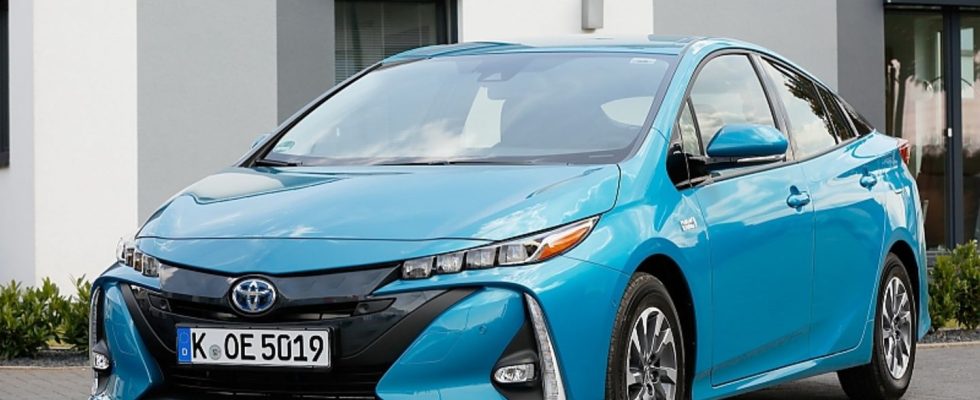Fascination: Toyota Prius through the ages
Trailblazer
Toyota Prius
© press-inform – the press office
What hasn’t the Toyota Prius been laughed at and loved over the past 25 years. The most famous hybrid vehicle of all time has evolved from an ugly eco-exotic into a contemporary everyday car. Despite all the electric trends, it retains its place in the Toyota range – in its current edition better than ever.
Toyota Prius – that stood for efficient, but anything but dynamic propulsion. According to the now departed Toyota CEO Akio Toyoda, a car has to be fun to be truly successful. Fun and a Toyota Prius – it’s difficult to fit together at first. The design was not very dynamic and the small four-cylinder with electric assistance took away any sportiness from the propulsion. After its market launch in Japan in 1997, the hybrid model went on a world tour in 2000. The initial 43 kW / 58 HP of the tired 1.5-liter naturally aspirated engine along with 30 kW / 40 HP from the electric module became a slightly faster 53 kW / 72 HP and the electric motor also increased imperceptibly to 33 kW / 44 HP.
Things are somewhat different with the second Prius generation, which celebrated its premiere in 2003/2004 with a hatchback design and was manufactured until 2009. Many have worked as taxis over the years because the Toyota Prius is particularly economical to drive in the city center and shows little wear and tear. The real consumption is barely more than five liters if you don’t scare the Toyota Prius too much on the highway. At 170 km/h it’s over anyway. On the one hand, this is due to the particularly efficient Atkinson cycle with increased efficiency and the automatic transmission in planetary design, which, similar to a CVT transmission, transfers the power and torque of the combustion engine and electric motor to the front axle. When accelerating hard, the Prius howls without the 1.4-ton Japanese driver getting to work particularly quickly. But economical – he can really do that. The eco-Japanese scores with a good amount of space at the front and especially in the rear. The approximately 400 liter cargo space can be significantly enlarged by folding down the rear seats. In terms of chassis and equipment, the Prius models from the 2006 model year are slightly better because the chassis and steering as well as interior details have been reworked. Top versions offer, among other things, navigation, leather seats and better lighting.
The boring image of the previous generations has now been forgotten, because the new fifth edition Toyota Prius not only looks good, its technology is also more up-to-date than ever. “I was asked to build a Prius that would break the image of a taxi and that people would cry for when they saw it on the road,” says chief engineer Satoki Oya. The proportions of the 4.60 meter long Toyota Prius are more pleasing than ever, not only thanks to the roofline, which is five centimeters flatter. 4.5 centimeters shorter and a wheelbase stretched by five centimeters are simply good for the economical Japanese. The rear passengers in particular are happy about the legroom they have gained in the second row. When it comes to operation, Toyota has improved with the new Prius. The central 12.3-inch display is much tidier than before, while the air conditioning can be controlled using a direct button. What’s disturbing, however, is the hard plastic charm of the Prius, which doesn’t fit into today’s times, and the digital instruments on the seven-inch screen, which doesn’t fit into today’s times with its outdated display.
Depending on the market, the fifth generation not only offers plug-in technology, optional all-wheel drive, but also up to 164 kW / 223 hp and a 13.6 kilowatt-hour battery in the underbody for a range of up to 70 kilometers. The new battery pack has 50 percent more capacity and 30 percent fewer cells with a higher energy density, takes up the same space and weighs approximately the same as the previous smaller battery. In some countries, the Prius is available with either without or plug-in drive, while the standard hybrid is also offered as an all-wheel drive, especially in the USA. When it comes to charging power, however, the PHEV is a bit tired, as it grew from just 3.3 to 3.5 kilowatts. A full charge used to take at least two hours, but now it will take up to four. The sleek front with the V-shaped LED headlight lines and the narrow radiator slit looks like a mix between the Hyundai i30 and a Lucid and comes around the corner much more dynamically than before. The two-liter gasoline engine delivers 112 kW / 152 hp and the transaxle electric motor contributes a further 120 kW / 160 hp. The standard consumption is 0.5 to 0.8 liters per 100 kilometers.
Rolling Prius chicane, that was once, because the Toyota Prius V is definitely fun, has more than enough power, especially as the top version, and shows this off more confidently than ever with its 19-inch wheelset. The steering is very smooth and always precise – there is significantly less rolling movement than before. The previous Prius struggled from a standstill to 100 km/h in well over ten seconds and the successor feels twice as fast at 6.8 seconds, even if a maximum speed of 177 km/h is a disappointment for the impressive engine performance. But what is most exciting is the new drivability, because even the otherwise annoying intermediate accelerations happen much more smoothly and quietly than before thanks to the new parallelism between engine noise and acceleration, despite the continuously variable transmission.

